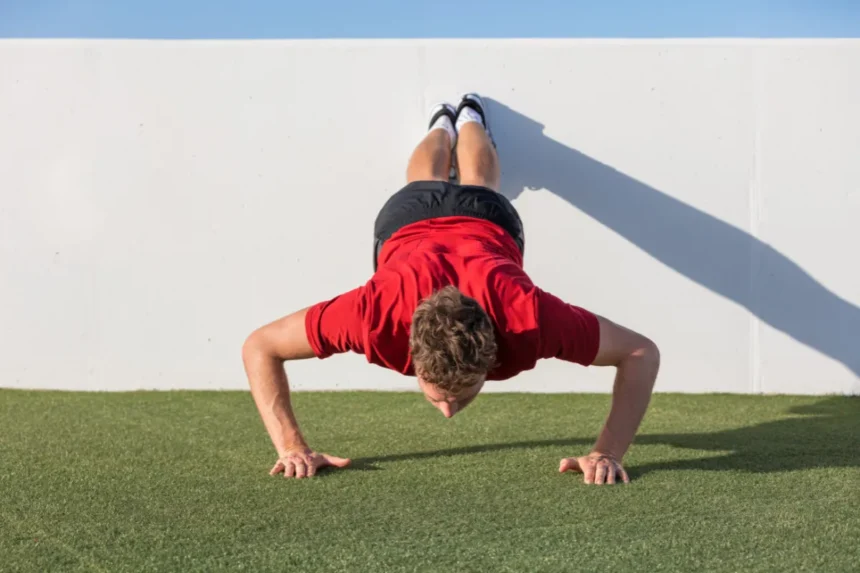In the realm of fitness and strength training, the push-up stands as a timeless exercise.
Its simplicity, accessibility, and effectiveness have made it a staple in workouts for individuals across all levels of fitness.
Over time, variations of the push-up have emerged, each targeting different muscle groups and offering unique challenges.
Among these variations, the decline push-up has gained popularity for its ability to intensify the workout and engage muscles in new ways.
In this article, we delve into the decline push-up, exploring its history, technique, benefits, and why it continues to be a valuable addition to any fitness routine.
History and Evolution:
The push-up itself dates back centuries, with its origins traced to ancient civilizations like Egypt and Greece, where it was used as a training exercise for soldiers and warriors.
However, the decline push-up, as we know it today, is a more recent development in the realm of fitness.
The decline push-up involves elevating the feet on a platform higher than the hands, thereby shifting more of the body’s weight onto the upper body muscles, particularly the chest, shoulders, and triceps.
This variation intensifies the exercise, making it more challenging than the traditional push-up performed on level ground.
The origins of the decline push-up are somewhat ambiguous, with various fitness communities and experts contributing to its development.
It likely evolved from the need to increase the difficulty of the push-up to continue challenging the body and promoting muscle growth and strength.
Over time, fitness enthusiasts and trainers experimented with different angles and heights to find the optimal position for maximum effectiveness.
Technique and Execution:
Proper technique is crucial when performing the decline push-up to ensure safety and maximize its benefits.
Here’s a step-by-step guide on how to perform the exercise correctly:
Begin by positioning yourself face-down on the ground, with your hands slightly wider than shoulder-width apart.
Place your feet on a raised platform, such as a bench or step, ensuring that your body forms a straight line from head to heels.
Engage your core and glutes to maintain stability throughout the exercise.
Lower your body by bending your elbows until your chest nearly touches the ground, keeping your elbows close to your sides.
Push through your palms to extend your arms and return to the starting position, fully extending your elbows without locking them.
Repeat for the desired number of repetitions.
It’s essential to maintain control throughout the movement, avoiding any bouncing or jerking motions that can strain the muscles or joints. Additionally, breathing plays a crucial role; exhale as you push up and inhale as you lower your body.
The decline push-up offers a range of benefits that make it a valuable addition to any workout routine. Here are some of the key advantages:
Benefits of the Decline Push-Up:
Increased Upper Body Strength:
By elevating the feet, the decline push-up places greater emphasis on the muscles of the chest, shoulders, and triceps, leading to increased strength and muscle growth in these areas.
Improved Muscle Engagement:
The angled position of the decline push-up engages stabilizer muscles to a greater extent, enhancing overall muscle activation and promoting balanced strength development.
Core Stability:
Performing decline push-ups requires increased core engagement to maintain proper form and stability, leading to improved core strength and stability over time.
Greater Range of Motion:
Compared to traditional push-ups, the decline variation allows for a deeper range of motion, enabling better muscle stretch and contraction, which can lead to greater muscle development and flexibility.
Versatility:
The decline push-up can be easily modified to suit different fitness levels by adjusting the height of the platform or incorporating additional variations, such as incorporating hand placements or adding resistance with weights or resistance bands.
Incorporating the Decline Push-Up into Your Workout:
Whether you’re a beginner or an experienced fitness enthusiast, the decline push-up can be a valuable addition to your workout routine. Here are some tips for incorporating this exercise effectively:
Start Slow:
If you’re new to decline push-ups, begin with a lower platform height or perform them on an incline to reduce the intensity until you build enough strength and stability to perform them on a higher surface.
Focus on Form:
Maintain proper form throughout each repetition, ensuring that your body remains in a straight line from head to heels and that your elbows are tucked close to your sides.
Gradually Increase Intensity:
As you become more comfortable with the exercise, gradually increase the height of the platform or experiment with different hand placements to increase the challenge and continue making progress.
Mix It Up:
Incorporate decline push-ups into your existing workout routine alongside other push-up variations and upper body exercises to target different muscle groups and prevent plateauing.
Listen to Your Body:
Pay attention to how your body responds to the exercise and adjust as needed.
If you experience any pain or discomfort, scale back the intensity or consult with a fitness professional for guidance.
Conclusion:
The decline push-up offers a challenging yet rewarding variation of the classic push-up exercise, targeting the muscles of the chest, shoulders, triceps, and core while promoting strength, stability, and muscle growth.
With proper technique and consistency, it can be a valuable addition to any fitness routine, whether you’re a beginner looking to build strength or an experienced athlete seeking to take your workouts to the next level.
By incorporating decline push-ups into your training regimen and adjusting the intensity as needed, you can continue challenging your body, achieving your fitness goals, and reaping the many benefits this exercise has to offer.

